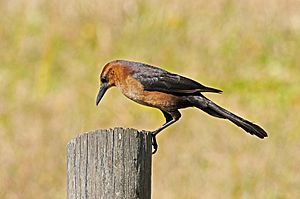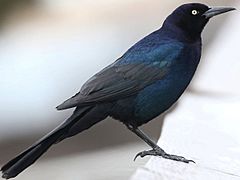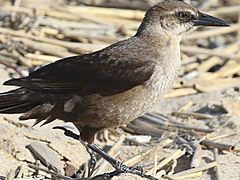Boat-tailed grackle facts for kids
The boat-tailed grackle (Quiscalus major) is a cool bird that lives all year long along the coasts of the Southeastern United States. It's a type of passerine bird, which means it's a perching bird. You can find these birds in salty marshes near the coast. In Florida, they also live near freshwater.
Boat-tailed grackles build their nests in trees or bushes close to water. Their nests are like hidden cup-shaped homes where they lay three to five eggs.
Quick facts for kids Boat-tailed grackle |
|
|---|---|
 |
|
| Male | |
 |
|
| Female | |
| Conservation status | |
| Scientific classification | |
| Genus: |
Quiscalus
|
| Species: |
major
|
 |
|
| Range of Q. major Year-round range Wintering range | |
Contents
What Do Boat-Tailed Grackles Look Like?
Males and Females Are Different
Male boat-tailed grackles are quite large, about 37 to 43 centimeters (15 to 17 inches) long. They weigh between 165 to 250 grams (5.8 to 8.8 ounces). Adult males have shiny, shimmery black feathers all over their bodies. They have a long, dark beak, light yellow or brown eyes, and a long tail shaped like the bottom of a boat.
Female boat-tailed grackles are much smaller than males. They are about 26 to 33 centimeters (10 to 13 inches) long and weigh 90 to 115 grams (3.2 to 4.1 ounces). Females also have a shorter tail and are reddish-brown. Their wings and tail are darker than the rest of their body.
Young Grackles and Eye Color
Young male grackles are black but don't have the shiny feathers that adult males do. Young females look like duller versions of adult females and might have spots on their chest.
The eye color of boat-tailed grackles can be different depending on where they live. Birds along the Gulf Coast and inland areas have dark eyes. But birds living along the Atlantic coast have pale eyes.
Where Do Boat-Tailed Grackles Come From?
The boat-tailed grackle was first described by a French scientist named Louis Jean Pierre Vieillot in 1819. Its scientific name, major, means "larger" in Latin.
There are four different types of boat-tailed grackles, called subspecies. These types vary a bit in size and eye color. The boat-tailed grackle used to be thought of as the same bird as the great-tailed grackle. However, the great-tailed grackle has an even longer tail and doesn't have the unique rounded head shape of the boat-tailed grackle.
The common grackle is another bird that often lives in the same areas as the boat-tailed grackle along the Atlantic coast. Common grackles are noticeably smaller and have shorter tails. They also don't have the rounded head shape.
What Do Boat-Tailed Grackles Eat?
These birds look for food on the ground, in shallow water, or in bushes. They are known to even steal food from other birds!
Boat-tailed grackles eat many different things, which means they are omnivores. Their diet includes insects, small fish called minnows, frogs, eggs, berries, seeds, grains, and sometimes even small birds.
In cities and towns along the Gulf Coast of the United States, boat-tailed grackles have become very common. You might see them looking for food in trash cans, dumpsters, and parking lots.
What Do Boat-Tailed Grackles Sound Like?
The boat-tailed grackle's song is a harsh sound that sounds like jeeb. They also make many other sounds, like chatters and squeaks, which are typical for grackles.
Images for kids
-
A male grackle sitting on a branch at Assateague Island National Seashore, Maryland.
-
A female grackle at Rodanthe Public Beach, North Carolina.
See also
 In Spanish: Zanate marismeño para niños
In Spanish: Zanate marismeño para niños





